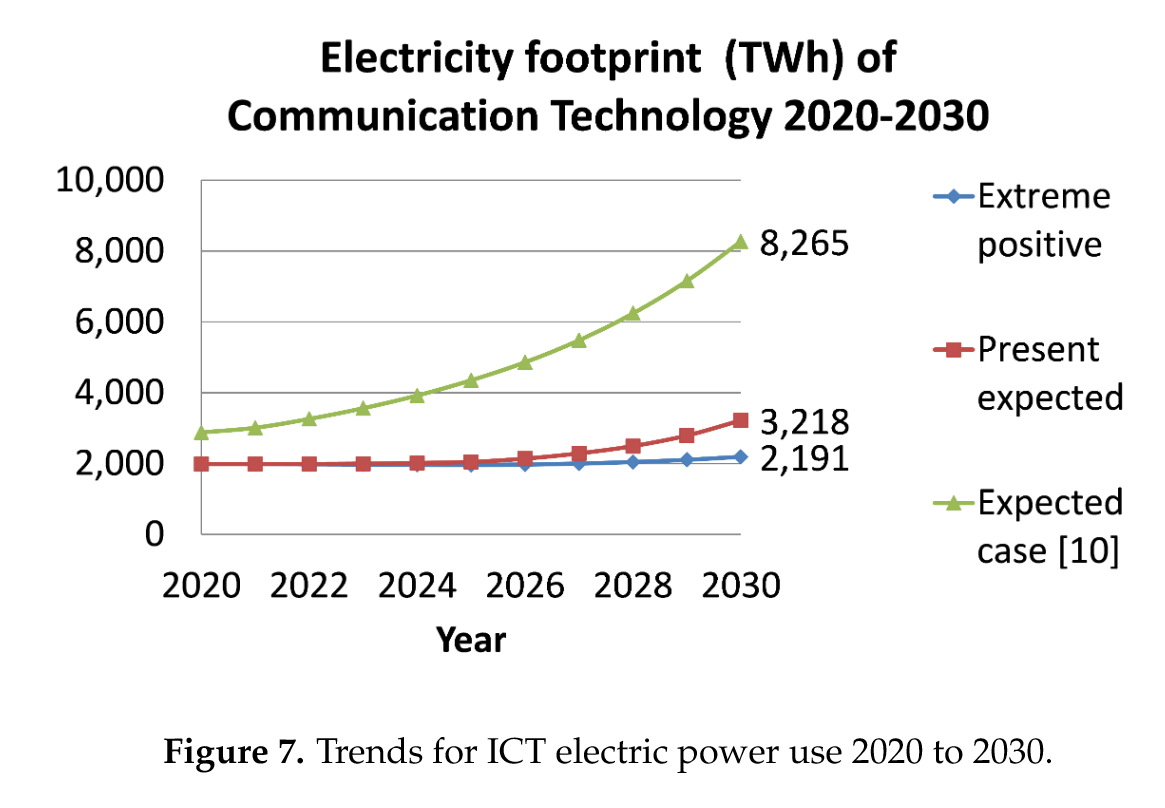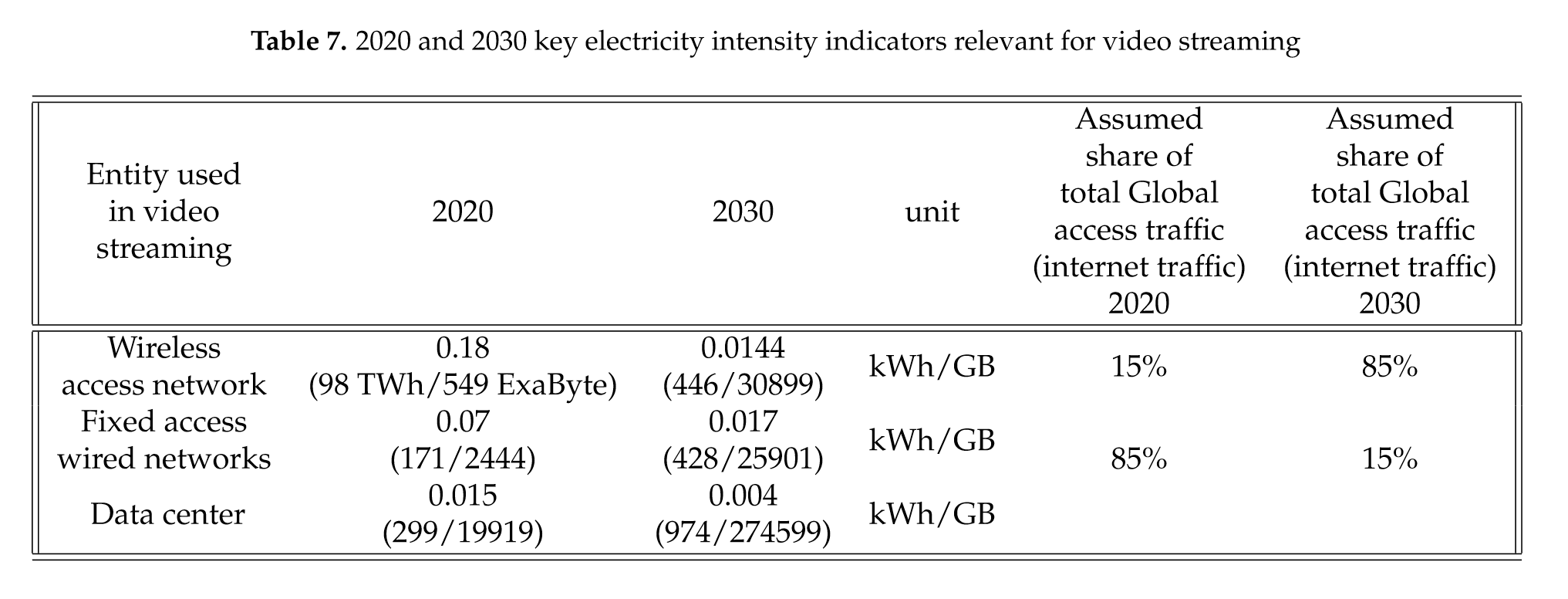New perspectives on internet electricity use in 2030
Status:: 🟩
Links:: Global energy consumption & carbon emissions of the whole ICT sector
Metadata
Authors:: Andrae, Anders
Title:: New perspectives on internet electricity use in 2030
Publication Title:: "Engineering and Applied Science Letters"
Date:: 2020
URL:: https://pisrt.org/psr-press/journals/easl-vol-3-issue-2-2020/new-perspectives-on-internet-electricity-use-in-2030/
DOI:: 10.30538/psrp-easl2020.0038
Bibliography
Andrae, A. (2020). New perspectives on internet electricity use in 2030. Engineering and Applied Science Letters, 3, 19–31. https://doi.org/10.30538/psrp-easl2020.0038
Zotero
Type:: #zotero/journalArticle
Keywords:: [✅, 💎, Climate Footprint]
Relations
Abstract
The main problems with several existing Information and Communication Technology (ICT) power footprint investigations are: too limited (geographical and temporal) system boundary, overestimation of power saving potential in the next decade, assume that historical power use can predict future global power use in the next decade despite unprecedented data traffic growth, assume that Moore's law relation to digital circuitry can continue "forever" and that no problems with extra cooling power will occur for several decades. The highly variable outlooks for the future power consumptions depend on "starting values", disruptions, regional differences and perceptual estimations of electricity intensity reductions and data traffic increase. A hugely optimistic scenario-which takes into account 20% annual improvement of the J/bit in data centers and networks until 2030 is presented. However, the electric power consumption of the present ICT scope will be significant unless great efforts are put into power saving features enabling such improvements of J/bit. Despite evident risks, it seems though that planned power saving measures and innovation will be able to keep the electricity consumption of ICT and the World under some kind of control. The major conclusion is based on several simulations in the present study-that future consumer ICT infrastructure cannot slow its overall electricity use until 2030 and it will use more than today. Data traffic may not be the best proxy metric for estimating computing electricity. Operations and J/operation seem more promising for forecasting and scaling of bottom-up models.
Notes & Annotations
📑 Annotations (imported on 2023-04-04#16:13:36)
Depending on scope, in 2020 ICT stands for up to 7% of the total global electricity use.
Most researchers agree that the data traffic - no matter how it is defined - will increase exponentially for several years as it has been doing the last decade. The disagreement concerns how fast and how large the ICT related power use will become in around 2030.
Anyway, a proper power analysis of the ICT Sector should include production of hardware including embedded chips, use of data centers, use of networks, and use of consumer communication devices.
Production is today around 20% of ICTs footprint but there is room for improving the precision.
Use stage power of data centers is now around 15%, but is expected to become one of the most important drivers for ICT electricity use.
Use stage power of Networks (wireless and core) is now at around 15% of ICT, but its share is expected to increase.
Use stage power of consumer devices (including Wi-Fi modems) is now at some 50% of ICT total power use but is ideally expected to decrease thanks to advanced power saving features.
The hypothesis is that the electric power consumption of the ICT Sector will increase along something in between the best and expected scenario as outlined by Andrae and Edler in 2015 [3] when adding new assumptions of data traffic and electricity intensity improvements.

The "extreme positive" scenario assumes that no slowdown of electricity intensity improvements happen after 2022 i.e. no gradually waning annual improvements from 2022 to 2030 as in the present baseline (expected case scenario) - and that 20% improvements still happen in Networks and Data Centers until 2030. In that case ICT power will more or less stay flat while the total data traffic grows 14 times between 2020 and 2030. The electricity use of networks and data centers will be 54% less in such an "extreme positive" scenario than in the present study.
Using renewable energy to power data centers and networks can reduce the environmental impacts. However, the uneven geospatial distribution of renewable energy resources and regions with high ICT use might create uncertainty of supply [20,21].
Overall the present predictions suggest a trajectory in between the Best and Expected Case Scenarios in [3], ≈1990 TWh in 2020 and 3200 TWh in 2030 (Figure 6). The ICT Sector has and will have a considerable share of the global electricity footprint.
📑 Annotations (imported on 2023-04-04#16:17:49)
Power analysis of the ICT sector:
- Production of ICT devices: ~20 %
- Use stage power of data centers: ~15 %
- Use stage power of networks: ~15 %
- Use stage power of consumer devices: ~50 %
📑 Annotations (imported on 2023-04-17#10:49:07)
However the total emission of ICT production - and thereby the power use - may well be heavily underestimated [10].
📑 Annotations (imported on 2023-06-23#18:35:47)
